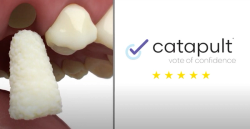- About Us
- Advertise
- Editorial
- Contact Us
- Terms and Conditions
- Privacy Policy
- Do Not Sell My Personal Information
© 2025 MJH Life Sciences™ and Dental Products Report. All rights reserved.
Recreating patient’s translucency
When creating restorations using pressable ceramics with the cut-back and layering technique, dental laboratory ceramists have traditionally cut-back and layered the buccal aspect of the restoration.
When creating restorations using pressable ceramics with the cut-back and layering technique, dental laboratory ceramists have traditionally cut-back and layered the buccal aspect of the restoration.
After a fully anatomical wax-up is pressed, the buccal surface of the restoration is cut-back and contoured with a rotary instrument to make room to apply successive layers of esthetic and effects ceramic restorative materials. While properly supporting soft tissue response, this step-by-step technique is used to deliver predictable and esthetically precise restorations with the patient’s desired shade and simulation of internal nuances of the teeth, resulting in seamlessly natural-looking dentition.1
In certain situations, however, cases present for which it’s beneficial to cut-back and layer from the lingual. This requires the laboratory ceramist to know which ingot will be best for the case combined with Impulse effects and Essence stains to achieve the desired final shade match.
About the material
Ideal for pressing all-ceramic restorations intended for cut-back and layering techniques, Ivoclar Vivadent’s IPS e.max Press offers optimal strength and esthetics compared to traditional all-ceramic materials while demonstrating excellent optical properties, including life-like translucency.2-5 Containing approximately 70% by volume needle-like crystals in a glassy matrix, the controlled size, shape and density of lithium disilicate’s structure allows for greater strength and durability.2,3 Lithium disilicate can be pressed using the lost wax technique (IPS e.max Press). Pressable lithium disilicate demonstrates a flexural strength of 400 MPa.3-5 Lithium disilicate restorations may be fabricated into a framework that can be veneered or, as in this particular case, a full-contour restoration that can be cut-back and characterized with ceramic stains and glazes.
Available in a variety of translucencies and opacities, including high translucency (HT), low translucency (LT)-both available in 16 A-D and 4 BL Shades-medium opacity (MO), high opacity (HO) and Impulse ingots available in three Value (V) and two Opal (O) shades, IPS e.max Press has a suitable ingot available for every patient situation, even the most challenging esthetic cases.6
Case presentation
A 47-year-old woman presented with concerns about her maxillary central incisor (Fig. A). During consultation, it was decided that tooth No. 8 would be restored with an IPS e.max Press all-ceramic full crown. Prior to restorative procedures, the patient agreed to undergo whitening of the dentition to ensure a uniform, esthetic shade for the final result (Fig. B). The teeth then were prepared according to manufacturer’s instructions for IPS e.max Press lithium disilicate glass-ceramic crowns. A final tooth shade was taken and determined to be 2M1.
When selecting shades, choosing the appropriate ingot and proper calibration of material to develop the desired translucency and blend the ceramic material with the tooth structure is essential. This leads to uniform restorations that are indistinguishable from the patient’s natural dentition.7,8 Having reviewed the final shade, the dental technician decided on an IPS e.max Press Impulse V1 pressable ingot.
Fabrication Process
01 After receiving all necessary case information from the dentist, including shade requirements, the case was ready to be pressed from an IPS e.max Press lithium disilicate glass-ceramic, currently the only material and technique available that allows pressing of 0.3 mm of material, making it the material of choice. Because of the optical properties and strength of lithium disilicate, the crown for tooth No. 8 would demonstrate the function and esthetics required of dentition in the anterior region.
02 The ideal wax-up was created to full contour on a solid model, and a matrix was then created. The incisal edges of tooth No. 8 were shaped in the wax-up and matrix to perfectly match the incisal edges of tooth No. 9.
03 The wax-up was then sprued, invested, burned-out and pressed using a V1 shade of IPS e.max. The material was chosen instead of traditional all-ceramic materials because of its exceptional quality of translucency, strength and durability.
04 After pressing, the sprues were removed and the restoration divested and placed in e.max Press Invex Liquid and blasted to eliminate the surface reaction layer. The restoration was then fit to the model and ready for cut-back, layering and staining (Figs. C, D).
05 The cut-back was performed by systematically grinding the lingual incisal edge (Figs. E, F). The translucency of the ingot, which is very important when matching the enamel with the ingot, rather than the ceramic is illustrated in Figs. G & H.
06 Essence stains were applied on the lingual to create internal effects similar to the patient’s natural dentition (Fig. I). The primary importance of the lingual cut-back technique is producing the internal, optical effects and exemplary esthetic properties of the final restoration. The lithium disilicate crown was then fired at 770°C (Fig. J).
07 The result was examined and Opal Effect (OE1) was applied to cover the palatal incisal edge (Fig. K).Opal Effect (OE1) was applied to compensate for shrinkage of the palatal porcelain application (Fig. L). As a final step, the crown was baked at 750°C.
08 After the bake, a natural and mechanical polish was completed using diamond paste and pumice to fully develop the desired surface texture of the full-contour crown. Once the restoration was completed, it was placed on the model to test fit and function. The case was then ready to be delivered to the dentist and patient for final cementation (Figs. M, N).
Conclusion
Creating a naturally translucent restoration requires a blend of science and artistry as well as time, patience and skill. Restorations need to be both technically correct and esthetically pleasing. Natural teeth possess nuances of shade and gradations of color, and dentition varies from person to person.
Each case must be assessed on its own merit. When creating a restoration indistinguishable from that of the patient’s natural dentition, conventional procedures may not always deliver optimal results. For instance, in cases that require a reduction in opacity and creation of a suitable incisal translucency, the lingual cut-back may be implemented to provide the opportunity to recreate the esthetics of the adjacent teeth.
About the author
Rafael Santrich, of VM Lab Technologies in Aventura, Fla., specializes in all fixed restorations and custom cosmetics. He has been featured in several publications such as “Soft Tissue and Esthetic Consideration in Implant Therapy” written by Dr. Anthony Sclar and on the ITI in 2009. He is currently a member of the American College of Prosthodontics.



